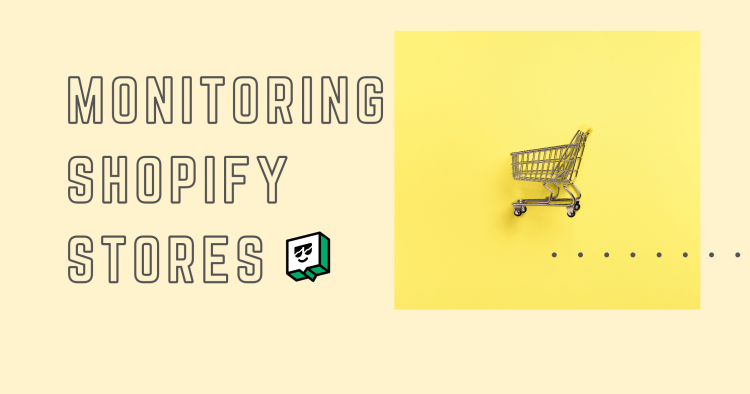
Monitoring Shopify Websites: Strategies for Optimizing Conversion Rates
After a year in business consistently meeting revenue benchmarks and audience cultivation goals, it’s time to reap the fruits of your labor by launching the store’s first new product line.
You’ve spent the last couple of months preparing for this day: stocking your inventory, cooking up ad creative for your social feeds, and perfecting marketing email subject lines. Now it’s time to sit back and watch those sales pour in—except they don’t.
It turns out your Shopify site has been stuttering and stalling since around midnight when the sales went live. Page load time is at an all-time low, and product images won’t load. Potential customers are abandoning their carts and taking your profits along with them.
To any e-commerce entrepreneur, this would be a disaster of Titanic proportions, with nary a Celine Dion power ballad to soothe you through the pain. While we’re no Canadian popstar, Uptime.com does have a fully stocked toolbox of monitoring tools to keep your online shop running at peak performance.
Let’s discuss how you can leverage the Uptime.com platform metrics to optimize your e-commerce conversions on a Shopify website.
Keep Your Website Up and Available
First and foremost is achieving a site uptime as close to 100% as possible.
When a Shopify site goes down, it’s the e-commerce equivalent of a brick-and-mortar store locking up for the day. There’s no revenue coming in, and you likely have disappointed patrons expecting to visit your business but are now heading to a competitor to get the products they need. Worse yet, frequent outages chip away at the trust and goodwill you’ve cultivated among your customer base and can take a serious toll on your business’s reputation.
Uptime.com’s always-on monitoring continuously checks whether your website is reachable and functioning so that you know something’s wrong before your customers do. You can schedule checks at intervals of your choosing and receive advanced notifications with the root causes and details on what’s thrown up the flag.
Decrease Page Load Times
For every second of load time between 0-5 seconds, conversion rates drop 4.42%, and the bounce rate goes up by 32% between 1-3 seconds. Hit 5 seconds, and 90% of users click away before you even get an opportunity to pitch your wares.
Page load times matter a lot and directly impact how effectively your Shopify site turns visitors into conversions into repeat customers. Your customers expect quick, responsive interactions regardless of the device they’re using, and if they can’t find that in your shop, they’ll seek out someone who can provide it.
Regular testing provides necessary insights into areas where you can improve your site speed. For example, Uptime.com tracks critical metrics like the initial server response and how long it takes for all the elements on your pages to render. With this information, you can better address the root of the problem with the appropriate fixes, whether implementing lazy loading or upgrading your hosting services to a CDN package that stores your assets closer to users.
Fix Issues Proactively With Synthetic Monitoring Tools
The adage says that an ounce of prevention is worth a pound of cure, especially for e-commerce sites. It’s far better to be proactive rather than reactive, waiting for your customers to report a problem before deploying the necessary fixes. Synthetic monitoring tools can help by providing an environment where you can simulate user interactions to resolve issues like broken links and bottlenecks before a customer encounters them.
Beyond allowing you to fix immediate issues, synthetic monitoring makes iterating and improving your site more efficient. Use the Uptime.com tools to test how actual customers might interact with site updates before they go live and prioritize the fixes that will have the most significant positive impact on conversion rates.
No coding experience? No problem.
Uptime.com offers a code-free interface with built-in field suggestions and simple commands, making creating a monitoring flow as easy as possible. Once you’ve added all necessary validations, checks, and schedules, our tool replicates an accurate user journey, including all mouse clicks and element interactions, in a Chromium browser environment for true-to-life insights.
Remove Transaction Friction With Real User Monitoring (RUM)
What do peanut butter and jelly, hot cocoa and marshmallows, and synthetic monitoring and real user monitoring have in common?
They’re way better when you use them together.
Unlike synthetic monitoring, RUM captures and analyzes how users actually interact as they navigate your Shopify website based on device, OS, browser, and geolocation. This real-world feedback, coupled with the insights from your synthetic monitoring, provides a comprehensive understanding of your site’s frontend performance and gives you an advantage when it comes to making improvements.
With Uptime.com, there’s no more speculating on why a customer bounced. Our unified platform takes RUM insights and correlates user events with site performance data so that you can correlate customer interactions with issues like slow load times and site errors. So, when you notice an increased bounce rate coinciding with a sudden spike in load times, you know with absolute certainty where your site is underperforming and can prioritize immediate fixes to remove that particular friction point.
Anyone working in e-commerce must do some level of “mind reading” to anticipate their customers’ wants, needs, and frustrations, then provide a Shopify experience that caters to these whims. While ESP would be a handy tool, Uptime.com is a close second, and you can try us out for 14 days before paying a dime! Register for a free trial—no credit card required—and see the positive difference of using site monitoring to optimize your Shopify website.
Minute-by-minute Uptime checks.
Start your 14-day free trial with no credit card required at Uptime.com.
 Uptime.com Blog
Uptime.com Blog


